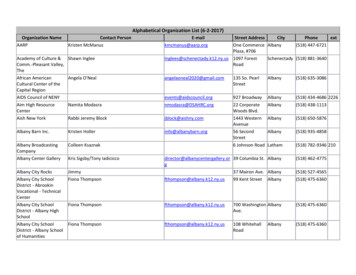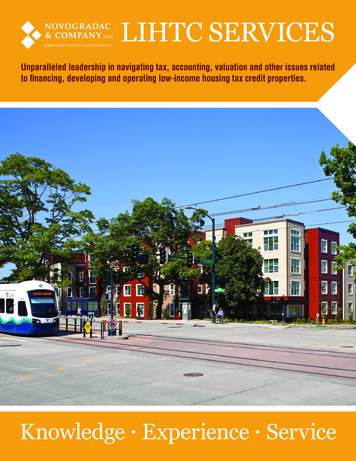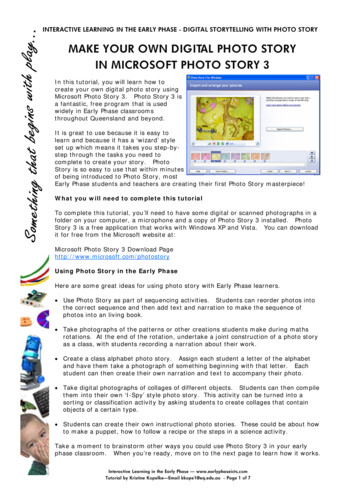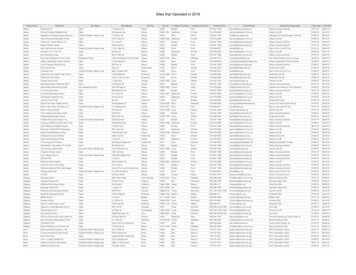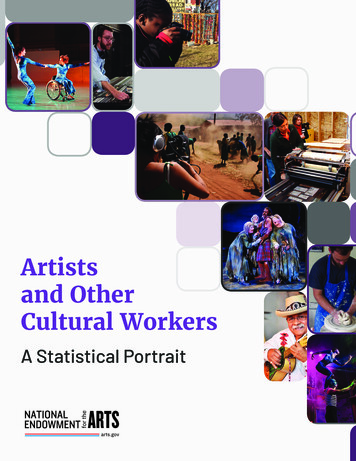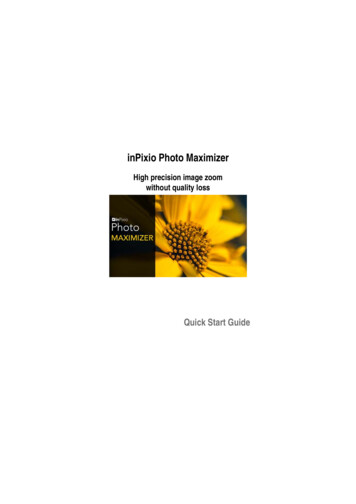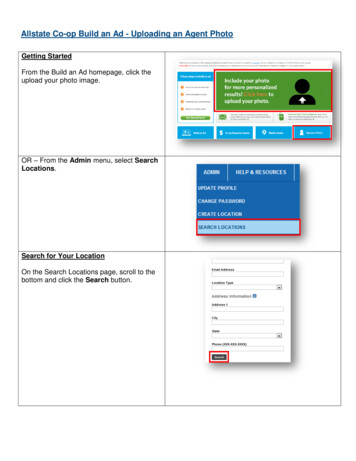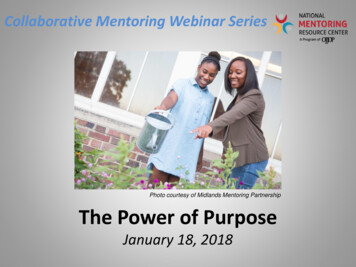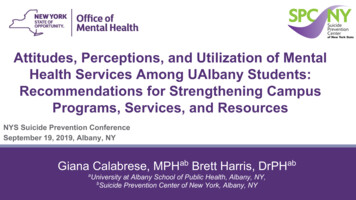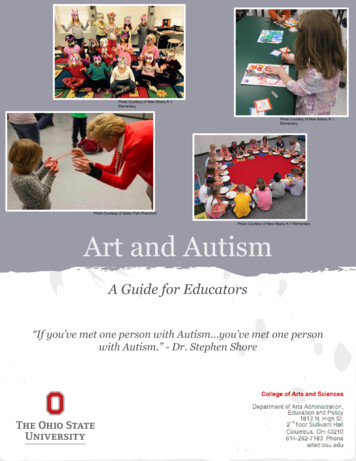
Transcription
Photo Courtesy of New Albany K-1ElementaryPhoto Courtesy of New Albany K-1ElementaryPhoto Courtesy of Sutter Park PreschoolPhoto Courtesy of New Albany K-1 ElementaryArt and AutismA Guide for Educators“If you’ve met one person with Autism.you’ve met one personwith Autism.” - Dr. Stephen Shore
Contents Autism: General Information---------------3 ----------3 ---------3 Signs and Symptoms-------------------------------3 Myths and Statistics-------------------------------4 --------------5 Formal Education Settings------------------6 Informal Education Settings----------------8 Resources for Educators---------------------9 ---------11 -----122
AutismWhat is Autism?Autism spectrum disorder (ASD) is a general term that engages a group of complexdisorders of neurological development. These disorders are characterized, in varyingdegrees, by deficits in social-emotional reciprocity, in nonverbal communicativebehaviors used for social interaction, and in developing, maintaining, andunderstanding relationships.Causes:Scientists are not certain what the exact cause of autism is, but there is an increasing understanding that bothgenetics and environment likely play a role. Studies suggest that ASD could result from the disruption ofnormal brain development early in fetal development caused by defects in genes that control brain growth andthat regulate how brain cells communicate with each other, possibly due to the influence of environmentalfactors on gene function, but all studies are preliminary and require further study.Signs and Symptoms:General Symptoms HyperactivityImpulsivityShort attention spanAggressionCausing self injuryTemper tantrumsUnusual eating and sleeping habitsUnusual mood or emotional reactionsLack of fear or more fear than expectedHypersensitivity to sensory inputPhoto Courtesy of Gigi’s Joy blogEarly Indicators No babbling or pointing by age 1No single words by 16 months or two-wordphrases by age 2No response to nameLoss of language or social skillsPoor eye contactExcessive lining up of toys or objectsNo smiling or social responsiveness.Later indicators Impaired ability to make friends with peersImpaired ability to initiate or sustain a conversationwith othersAbsence or impairment of imaginative and socialplayStereotyped, repetitive, or unusual use of languagerestricted patterns of interest that are abnormal inintensity or focusPreoccupation with certain objects or subjectsInflexible adherence to specific routines or rituals.3
Autism Continued.Statistics Autism spectrum disorder (ASD) now affects 1 in 68 children and 1 in 42 boysBoys are nearly five times more likely than girls to have ASDThere is no current medical detection or cure for autismAbout 1 percent of the world population has autism spectrum disorder.More than 3.5 million Americans live with an autism spectrum disorder.Prevalence of autism in U.S. children increased by 119.4 percent from 2000 (1 in 150) to 2010 (1 in68). Autism is the fastest-growing developmental disability.Prevalence has increased by 6-15 percent each year from 2002 to 2010. (Based on biennial numbersfrom the CDC)Autism services cost U.S. citizens 236-262 billion annually.A majority of costs in the U.S. are in adult services – 175-196 billion, compared to 61-66 billion forchildren.In 10 years, the annual cost will be 200-400 billion.The U.S. cost of autism over the lifespan is about 2.4 million for a person with an intellectualdisability, or 1.4 million for a person without intellectual disability.35 percent of young adults (ages 19-23) with autism have not had a job or received postgraduateeducation after leaving high school.It costs more than 8,600 extra per year to educate a student with autism. (The average cost ofeducating a student is about 12,000)MythsTruthsAll individuals with autism have savant abilitiesApproximately 1 in 10 may exhibit savant skillsThe diagnosis of autism is relatively newAutism was first diagnosed in 1908Autism is a mental health disorderAutism is a neurological disorderAutism is caused by vaccinesSuch evidence has been refutedAutism is caused by poor parentingBoth genetics and environment likely play a roleAutism is caused solely by environmental factorsBoth genetics and environment likely play a roleIndividuals with autism are unable to form meaningfulsocial relationshipsThe diagnosis of autism does not explicitlydetermine one’s level of social abilityPeople with autism are cold and lack empathetic feelingsThe diagnosis of autism does not explicitlydetermine one’s level of empathyTherapies and programs for individuals with autism workacross the boardTherapies and programs may work differentlyper individualPeople who are not diagnosed with autism will neverexhibit characteristics similar to the characteristics ofthose who have been diagnosedPeople who are not diagnosed with autism canexhibit characteristics similar to those diagnosedwith autism4
History1952In the first edition of theDiagnostic and StatisticalManual of Mental Disorders(DSM), autistic-like symptomsare classified under childhoodschizophrenia.t1975The Developmentally DisabledAssistance and Bill of Rights Act (TheDD Act), revises the definition of"developmental disability" to includeautism.1908Swiss psychiatrist Eugen Bleulerfirst uses the term "autistic" todescribe a form of schizophreniathat is characterized by withdrawal.1971The first major scientific journal dedicated toautism research - The Journal of Autism andDevelopmental Disorders - is established. Inthe same year, Israel Kolvin's research beginsto show differences between autism andschizophrenia.1980In the third edition of the DSM,autism receives a separatediagnostic category for the first time.1993The "neurodiversity" movement is started byJim Sinclair, an autistic adult, when he givesa speech titled "Don’t Mourn for Us" at theInternational Conference on Autism.1994The fourth edition of the DSM adds severalsubtypes to the "autism spectrum,"including Asperger’s (50 years after it isidentified), Rett’s Disorder, ChildhoodDisintegrative Disorder, and PervasiveDevelopmental Disorder-Not OtherwiseSpecified (PDD-NOS).2013With the release of the fifth edition of the DSM,subtypes of autism spectrum disorder(Asperger's and Rett's) are eliminated.Individuals are now diagnosed as having anautism spectrum disorder (ASD) with varyinglevels of severity.2015The Centers for Disease Control &Prevention’s Autism and DevelopmentalDisabilities Monitoring (ADDM) Networkestimates that 1 in 68 children arediagnosed with Autism Spectrum Disorder(ASD) every year.5
Formal Education SettingsHow Autism Can Affect the Student:Challenges may include. Sustained attentionVisually-based reasoning skillsGoal-orientation, planning, and self-monitoring (executive dysfunction)Imitation skills that involve sequences of movements and symbolic movementsUnderstanding others’ intentions, mental states, speech, perspectives, language and social skillsLearning complex fine motor skillsUnderstanding abstract conceptsProcessing and regulating sensory inputOrganizing information and routines.Raised levels of anxietyRegulating emotionsPreferences may include: Visual directions and instructions (lists, icons)Answering choice-based questions instead of open-ended questionsOne question at a time that requires a concrete answerRepetitionCues for transitioning from one activity to the next.Prompts for answering questionsIncorporating a preferred special interestStructure and samenessPhoto Courtesy of New Albany K-1ElementaryHow Art Can Impact a Student with Autism:The arts provide independence and collaboration, demonstrate a process of self-expression, imagination andcreativity, and create a way to understand difficult abstractions.The impact of visual arts includes: Assisting with the development of cognitionDeveloping meaningful self-expressionIncreasing imagination and abstract thinkingImproving visual-spatial discrepanciesImproving fine motor skillsIncreasing communication and social interactionImproving copingDeveloping self-management and organizational abilitiesThe impact of performing arts (Dance, Music, Theatre) includes. Photo Courtesy of New Albany K-1ElementaryDeveloping HOT (higher order thinking) skills like analysis, synthesis, evaluation and problem solvingEnhanced ability to focus and interact with othersDeveloping communication skills (expression, auditory awareness, rhythmic speaking)Stimulating the transmission of information in the brainReorganization of the brain by utilizing both hemispheres.Encouraging collaborationDeveloping social skills (responding to others, taking turns, sharing ideas)Developing fine motor skills (rhythm, instruments)6
Formal Education Settings Continued.How Autism Can Affect the Educator:Educators should. Use visualsMaintain clear structure in the classroomCapitalize on the student’s interests and determine what motivates the studentTeach relaxation techniquesProvide choices to open-ended questionsApply rules consistentlyPrepare student for transitionsCommunicate with team membersExplore why a behavior happens and develop a specific strategyUse clear, direct instruction with precise languageProvide visual steps and schedulesUse imitation (“I do, you do”)Use visuals and hands-on activitiesFocus on strategies that enable a student to complete a task independentlyLook at problems through the eyes of the studentDemonstrate and model expected skillsMake eye contactPhoto Courtesy of New Albany K-1Use proximity and verbal remindersElementaryReinforce a non-preferred activity with a preferred activityConsider modifications if needed (number of items to complete, extra time, varying the responsemode, location of desk/materials, sensory materials to increase engagement)How Autism Can Affect the Classroom:In the classroom. Carefully consider what materials to use to meet that individual’s needsLimit the supplies that are out and availableBe aware of noise, especially background noiseUse proximity and prepare ahead with a seating chartPost classroom rulesTeach in front of a blank background (wall charts and posters can be distracting)Store unnecessary equipment and supplies in cabinetsKeep materials for students to access in a labeled, accessible, consistent locationDefine personal space and leave room between desks and tablesAvoid changing the classroom after it is set-upProvide a quiet space free of visual distractionsAvoid air fresheners and perfumesImage Aquired From www.dewberry.com7
Informal Education Settings(Including museums, community centers, non-profit orgs, etc.)How Autism Can Affect the Student:Challenges may include. Less structured environment can be overwhelmingIssues with the “classroom” space Too much space Acoustics/soundWith less structure, social impairment may be more pronouncedAdvantages may include Photo Courtesy of Sutter Park PreschoolLess structured environment can give students more freedomPresents alternative social opportunities for communication and expressionInformal setting implies voluntary participation, which can lead to intrinsic motivation to participateLess outcomes based, more student centeredHow Art Can Impact a Student with Autism:Informal and community arts education programs: Provide a medium for expression and communicationFacilitate social interactions and acceptance of “typical” peersInspire motivation to learn and to createHelp children with Autism to self-sootheProvide hands-on experiences to help children learn through non-traditional experiencesEvidence shows that students with autism who participated in a museum educationprogram: Decreased internalizing behaviorsDecreased hyperactivityIncreased “acceptable” socialization behaviorsImproved self-esteemHow Autism Can Affect the Educator:Effects are similar to formal education, but differences in environment presentadditional issues: Often teachers have less control of the classroom space, so it is important to find other ways to adaptOften, teachers see smaller groups of students, so can provide more one-on-one attentionEncourage students that there are no wrong answersPlan a consistent schedule as much as possible - routine is importantBreak down activities into smaller steps to prevent overstimulationGradually introduce new materials or activitiesInclude the familyStart smallUse tokens or a reward system to encourage participationPreview activities before diving inPhoto Courtesy of Sutter Park PreschoolBe prepared and well-informed about Autism and potential challenges8
Resources for EducatorsAdvocacy GroupsThe Autism Society of OhioAutism SpeaksVSA OhioOhio Center for Autism and Low Incidence (OCALI)BooksArt as an EarlyInterventionTool forChildren withAutism (2009)by Nicole MartinThe Art ofAutism:ShiftingPerceptions(2012) by DebraHosseiniMusic inSpecialEducation(2010) by MaryS. AdamekA Complete Guide toTeaching Art to Thosewith Autism: Utilizing theElements and Principlesof Design and Life Skills(2011) by Mishawn K.ReynoldsDrawingAutism (2014)by Jill MullinTeachingAdolescents withAutism: PracticalStrategies for theInclusive Classroom(2011) by Walter GKaweskiUnderstandingStudents withAutism through Art(2010) by BeverlyLevett Gerber andJulia Kellman9
Resources for Educators continued.WebsitesAutism Classroom: On this site you will find information about teaching children with autism and developmentaldisabilities, running a successful autism classroom, setting up spaces in the home and community for a child withautism, locate books and apps helpful in educating children with autism and find training options.www.autismclassroom.comAutism in the Museum: A clearinghouse of best practices, models, ideas, resources and research about makingmuseums, zoos, aquariums and other informal educational settings both welcoming and inclusive for people withautism and their families.http://www.autisminthemuseum.org/The Autism Society: The Autism Society, the nation’s leading grassroots autism organization, exists to improvethe lives of all affected by autism. We do this by increasing public awareness about the day-to-day issues faced bypeople on the spectrum, advocating for appropriate services for individuals across the lifespan, and providing thelatest information regarding treatment, education, research and advocacy.http://www.autism-society.org/Autism Speaks: School Community Toolkit: The purpose of this kit is to provide helpful information aboutstudents with autism and tools and strategies to achieve positive interactions and increase learning for all membersof the school community.www.autismspeaks.org/schoolEducate Autism: Educational resources and teaching materials.www.educateautism.comNational Autism Network: The National Autism Network is the largest online resource for the autism communityproviding a social network, nationwide provider directory, events calendar, discussion forums, autism news, expertwritten content and thousands of tmlNational Autism Resources: National Autism Resources Inc. is a global leader in providing cost effective,research based therapeutic tools that meet the needs of people on the autism spectrum across their lifespan since2008. www.nationalautismresources.comNational Education Association Autism Resources for Teachers: Includes links to information on autism,instructional methods, helpful techniques, activities and materials.http://www.nea.org/home/15151.htmUSC Rossier Online: Teacher’s Toolkit for Autism Awareness Month: m-awareness-month/VSA Ohio: VSA Ohio is a community that connects inspired artists with their passion, service providers withresources, and all citizens with creative opportunities. By bridging arts and disability, our programs and servicesconstantly evolve to provide inclusive environments and accessible opportunities for people with disabilities tocelebrate life through the arts.http://www.vsao.org/10
GlossaryABA (Applied Behavioral Analysis): A common therapy used to help kids with autism learn to behave moretypically using a system of rewards.Asperger Syndrome: A developmental disorder related to autism and characterized by higher than averageintellectual ability coupled with impaired social skills and restrictive, repetitive patterns of interest and activities.Autism: a mental condition, present from early childhood, characterized by difficulty in communicating andforming relationships with other people and in using language and abstract concepts.Autism Spectrum Disorder (ASD): Is a general term that engages a group of complex disorders ofneurological development. These disorders are characterized, in varying degrees, by deficits in socialemotional reciprocity, in nonverbal communicative behaviors used for social interaction, and in developing,maintaining, and understanding relationships.Differentiated Instruction: Is the way in which a teacher anticipates and responds to a variety of studentneeds in the classroom. To meet student needs, teachers differentiate by modifying the content (what is beingtaught), the process (how it is taught) and the product (how students demonstrate their learning).Formal Education: Is classroom-based, provided by trained teachers.Higher Order Thinking (HOT) Skills: A concept of education reform based on learning taxonomies (such asBloom's Taxonomy). Higher order thinking skills include critical, logical, reflective, metacognitive, and creativethinking.IEP (Individualized Education Plan): Is a plan or program developed to ensure that a child who has adisability identified under the law and is attending an elementary or secondary educational institution receivesspecialized instruction and related services.Informal Education: Educational experiences that take place outside of the formalized educational system (i.e. community arts organizations, voluntary and amateur arts organizations, museums, etc.)PDD-NOS: PDD-NOS stands for Pervasive Developmental Disorder Not Otherwise Specified. PDD-NOSbecame the diagnosis applied to children or adults who are on the autism spectrum but do not fully meet thecriteria for another ASDPerseveration: Repetitive use of language, such as repeating the same phrase over and over or repeatedlybringing up the same topicSensory Dysfunction/Sensory Integration: Children with autism experience light, sound, smells and tastesmore or less intensely than other people. As a result, they may be very easily overwhelmed by bright lights orloud noises; alternatively, they may crave lots of crashing, jumping and strong tastes.11
ReferencesAdamek, M. S., & Darrow, A.-A. (2005). Music in special education. Silver Spring, MD: American Music TherapyAssociation.American Psychiatric Association. (2013). Diagnostic and statistical manual of mental disorders(5th ed.). Arlington, VA: American Psychiatric Publishing.Autism. (n.d.). Retrieved July 30, 2015, from what-autismAutism Costs More Than 2 Million Over Patient's Life. (2014, June 10). Retrieved July 30, 2015, from feAutism Myths and Misconceptions. (n.d.). Retrieved July 29, 2013, from d-misconceptions.phpA Cultural History of Autism. (n.d.). Retrieved July 30, 2015, from timeline.php#.VbofqbdLoiFEpp, K.M. (2008). Outcome-based evaluation of a social skills program using art therapy and group therapy for childrenon the Autism spectrum. Children & Schools, 30(1).Facts about Autism. (n.d.). Retrieved July 30, 2015, from ut-autismFurniss, G. J. (2008, April). Designing Art Lessons for Children with Asperger Syndrome. SchoolArts, 107(8), 20.Furniss, G. J. (September 2008). Celebrating the Artmaking of Children with Autism. Art Education, 61(5), 8–12.Gerber, B. L., Kellman, J., & National Art Education Association. (2010). Understanding students with autism through art.Lynch, R.T., Chosa, D. (1996). Group-oriented community-based expressive arts programming for individuals withdisabilities: Participant satisfaction and perceptions of psychosocial impact. Journal of Rehabilitation.Schleien, S.J., Mustonen, T., Rynders, J.E. (1995). Participation of children with Autism and non-disabled peers in acooperatively structured community art program. Journal of Autism and Developmental Disorders, 25(4).Schleien, S.J., Ray, M.T., Soderman-Olson, M.L., McMahon, K.T. (1987). Integrating children with moderate to severecognitive deficits into a community museum program. Education and Training in Mental Retardation, 22(2).Signs and Symptoms. (2015, February 26). Retrieved July 30, 2015, from http://www.cdc.gov/ncbddd/autism/signs.htmlTexas Statewide Leadership for Autism Training (2011). TARGET: Texas Guide for Effective Teaching, EducationalImplications. Available from ce-guide-for-effective-teachingWan, C. Y., Demaine, K., Zipse, L., Norton, A., & Schlaug, G. (May 31, 2010). From music making to speaking: Engagingthe mirror neuron system in autism. Brain Research Bulletin, 82, 161-168.12
Notes13
14
Special Thanks to ourConference Partners!Bittersweet Farms - http://www.bittersweetfarms.orgVSA Ohio -Erin Hoppe @ ehoppe@vsao.orgAutism Network -Nationwide Children’s Hospital, Amy Hess @ Amy.Hess@nationwidechildrens.orgAutism Society of Ohio - http://www.autismohio.orgSondra Williams and OCALI (also runs a camp called SPEAK)Food for Good Thought - http://foodforgoodthought.com/Audrey Todd, PhD - todd@foodforgoodthought.comThis guide was created by Lindsay Harrington, Cameron Sharp, and Elle Pierman15
Photo Courtesy of Sutter Park Preschool Photo Courtesy of Sutter Park Preschool 8. Resources for Educators Advocacy Groups The Autism Society of Ohio Autism Speaks VSA Ohio Ohio Center for Autism and Low Incidence (OCALI) Music in Special Education (2010) by Mary S. Adamek A Complete Guide to
